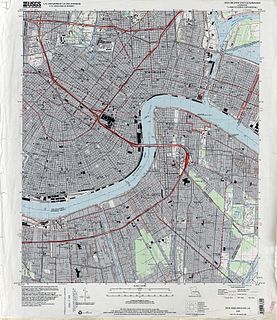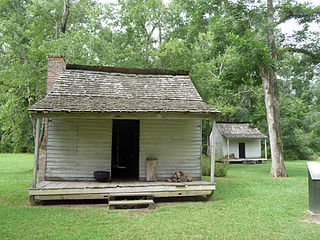
The French Quarter, also known as the Vieux Carré, is the oldest neighborhood in the city of New Orleans. After New Orleans was founded in 1718 by Jean-Baptiste Le Moyne de Bienville, the city developed around the Vieux Carré, a central square. The district is more commonly called the French Quarter today, or simply "The Quarter," related to changes in the city with American immigration after the 1803 Louisiana Purchase. Most of the extant historic buildings were constructed either in the late 18th century, during the city's period of Spanish rule, or were built during the first half of the 19th century, after U.S. purchase and statehood.

The Garden District is a neighborhood of the city of New Orleans, Louisiana, United States. A subdistrict of the Central City/Garden District Area, its boundaries as defined by the New Orleans City Planning Commission are: St. Charles Avenue to the north, 1st Street to the east, Magazine Street to the south, and Toledano Street to the west. The National Historic Landmark district extends a little farther.

Fort St. Philip is a historic masonry fort located on the eastern bank of the Mississippi River, about 40 miles (64 km) upriver from its mouth in Plaquemines Parish, Louisiana, just opposite Fort Jackson on the other side of the river. It formerly served as military protection of New Orleans, some 80 miles (130 km) up the river, and of the lower Mississippi River.

The St. Charles Streetcar line is a historic streetcar line in New Orleans, Louisiana. It is the oldest continuously operating streetcar line in the world, as it has been in operation since 1835. It is operated by the New Orleans Regional Transit Authority (RTA). Officially the St. Charles Streetcar line is internally designated as Route 12, and it runs along its namesake street, St. Charles Avenue. It is the busiest route in the RTA system as it is heavily used by local commuters and tourists. On most RTA maps and publications, it is denoted in green, which is also the color of the streetcars on this line.

Uptown is a section of New Orleans, Louisiana, United States, on the east bank of the Mississippi River, encompassing a number of neighborhoods between the French Quarter and the Jefferson Parish line. It remains an area of mixed residential and small commercial properties, with a wealth of 19th-century architecture. It includes part or all of Uptown New Orleans Historic District, which is listed on the National Register of Historic Places.

The Pitot House is a historic landmark in New Orleans, Louisiana, and is listed on the National Register of Historic Places.

The Old Louisiana State Capitol, also known as the State House, is a historic government building, and now a museum, at 100 North Boulevard in Baton Rouge, Louisiana, U.S.A.. It housed the Louisiana State Legislature from the mid-19th century until the current capitol tower building was constructed in 1929-32.

The Presbytère is an architecturally important building in the French Quarter of New Orleans, Louisiana. It stands facing Jackson Square, adjacent to the St. Louis Cathedral. Built in 1791 as a matching structure for the Cabildo, which flanks the cathedral on the other side, it is one of the nation's best examples of formal colonial Spanish architecture. It was designated a National Historic Landmark in 1970, and is now a property of the Louisiana State Museum.

St. Patrick's Church is a Catholic church and parish in the Archdiocese of New Orleans, Louisiana, United States. The parish was founded in 1833, and the current structure was completed in 1840. It is the second-oldest parish in New Orleans, located upriver from the French Quarter at 724 Camp Street in what is now the Central Business District. The building, a National Historic Landmark, is one of the nation's earliest and finest examples of Gothic Revival architecture.

The House on Ellicott's Hill, also known as Connelly's Tavern, James Moore House, or Gilreath's Hill, is a historic house museum at 211 North Canal Street in Natchez, Mississippi. Built in 1798, it is the oldest surviving building in Natchez from its early territorial period. It was declared a National Historic Landmark in 1974 and a Mississippi Landmark in 2001.

The Napoleon House, also known as the Mayor Girod House or Nicolas Girod House, is a historic building at 500 Chartres Street in the French Quarter of New Orleans, Louisiana, United States. Built in 1794 and enlarged in 1814, its name derives from the local legend that it was intended as a residence for Napoleon Bonaparte after his exile. A plan to bring Napoleon to Louisiana was halted by news of his death in 1821.

The George Washington Cable House is a historic house at 1313 8th Street, in the Garden District of New Orleans, Louisiana. Built in 1874, it was the home of George Washington Cable (1844–1925), an American writer who described Creole life, during the period in which he rose to national prominence. The cottage was declared a National Historic Landmark in 1962.

Gallier House is a restored 19th-century historic house museum located on Royal Street in the French Quarter of New Orleans, Louisiana.

Louisiana State Bank Building is a historic commercial building at Royal and Conti Streets in the French Quarter of New Orleans, Louisiana. Built in 1820, it was the last structure designed by nationally prominent architect Benjamin Henry Latrobe, who died from yellow fever in New Orleans before its construction. It has also been known as the Manheim Galleries building, from a long-time tenant. More recently, it has housed "Latrobe's", an event venue. It was declared a National Historic Landmark in 1983.

San Francisco Plantation House is a historic plantation house in Garyville, St. John the Baptist Parish, Louisiana. Built in 1853-1856, it is one of the most architecturally distinctive plantation houses in the American South. It was declared a National Historic Landmark in 1974. It is now a museum and event facility.

Ursuline Convent was a series of historic Ursuline convents in New Orleans, Louisiana. In 1727, nuns from the Ursuline Convent of Rouen (Normandy) went to New Orleans to found a convent, run a hospital, and take care of educating young girls.

The U.S. Custom House, also known as the Old Post Office and Custom House, is a historic government building at 423 Canal Street in New Orleans, Louisiana. It was designated a National Historic Landmark, receiving this designation in 1974 and noted for its Egyptian Revival columns. Construction on the building, designed to house multiple federal offices and store goods, began in 1848 and didn't finish until 1881 due to redesigns and the American Civil War. The U.S. Customs offices have been located there since the late 19th century.

Audubon State Historic Site is a state park property in West Feliciana Parish, Louisiana, between the towns of St. Francisville and Jackson. It is the location where noted ornithologist and artist John James Audubon spent the summer of 1821.

James Hardy Dillard, also known as J. H. Dillard, was an educator from Virginia. The son of slaveholders, Dillard was educated at Washington and Lee University and held a variety of teaching positions. In 1891, Dillard was named a professor at Tulane University in New Orleans, Louisiana.






















